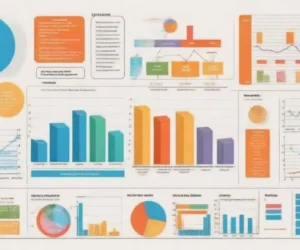
Machine Learning Algorithms for Map Generalization Classification

- Decision Trees for Map Generalization
- Random Forests for Map Generalization
- Support Vector Machines for Map Generalization
- Naive Bayes for Map Generalization
- Neural Networks for Map Generalization
- K-Nearest Neighbors for Map Generalization
- Gradient Boosting for Map Generalization
- Ensemble Methods for Map Generalization
- Clustering Algorithms for Map Generalization
- Genetic Algorithms for Map Generalization
Decision Trees for Map Generalization
Decision trees are a popular choice for map generalization classification due to their simplicity and interpretability. They work by recursively splitting the data into subsets based on feature values, resulting in a tree-like model of decisions. Each node in the tree represents a feature, and each branch represents a decision rule, leading to a final classification at the leaf nodes.
The intuitive nature of decision trees makes them easy to understand and implement. They can handle both numerical and categorical data, making them versatile for various types of map data. Moreover, decision trees can be visualized, which helps in understanding the decision-making process.
However, decision trees can be prone to overfitting, especially with complex datasets. Pruning techniques or ensemble methods, such as random forests, can help mitigate this issue, providing more robust models for map generalization.
How Decision Trees Work
Decision trees start with the entire dataset and select the best feature to split the data based on a criterion like Gini impurity or information gain. This process continues recursively, creating branches until a stopping condition is met, such as a maximum depth or a minimum number of samples per leaf.
Combining Machine Learning ModelsHere's a basic example of a decision tree classifier in Python using scikit-learn:
from sklearn.tree import DecisionTreeClassifier
# Assuming X_train and y_train are predefined
model = DecisionTreeClassifier()
model.fit(X_train, y_train)
# Predicting with the model
predictions = model.predict(X_test)The tree structure helps in understanding how the model makes decisions. Each node represents a decision point based on a feature, and the branches indicate the possible outcomes.
Advantages of Decision Trees
Decision trees are highly interpretable and straightforward to implement. They don't require scaling of the data and can handle both numerical and categorical features. Additionally, they can capture non-linear relationships between features, making them suitable for various tasks in map generalization classification.
Another advantage is their ability to handle missing values by assigning surrogate splits. This feature allows decision trees to maintain performance even with incomplete data. However, the simplicity of decision trees can lead to overfitting, which is why ensemble methods are often preferred.
The Impact of Data Normalization on Machine Learning ModelsRandom Forests for Map Generalization
Random forests improve upon decision trees by constructing multiple trees and aggregating their results. This ensemble method enhances accuracy and robustness, making it a powerful tool for map generalization classification.
Random forests mitigate the overfitting problem of single decision trees by averaging the results of numerous trees. Each tree in the forest is trained on a bootstrap sample of the data, and feature selection is randomized, ensuring diversity among the trees.
Feature Selection and Preprocessing
In random forests, feature selection is randomized to ensure that the trees in the ensemble are diverse. This process helps in capturing different aspects of the data and reduces the risk of overfitting. Preprocessing steps, such as handling missing values and scaling features, are essential for improving model performance.
Here's how to implement a random forest classifier in Python:
Data Pipeline vs Machine Learning Pipelinefrom sklearn.ensemble import RandomForestClassifier
# Assuming X_train and y_train are predefined
model = RandomForestClassifier(n_estimators=100)
model.fit(X_train, y_train)
# Predicting with the model
predictions = model.predict(X_test)The random forest model aggregates the predictions of individual trees to make a final decision, improving accuracy and stability.
Training and Evaluation
Training a random forest involves selecting a subset of features and data points for each tree, ensuring that the trees are diverse and complementary. The model is evaluated using metrics like accuracy, precision, recall, and F1-score to determine its effectiveness in map generalization classification.
During training, hyperparameters such as the number of trees, maximum depth, and minimum samples per leaf can be tuned to optimize performance. Cross-validation techniques are often used to assess the model's generalizability.
Support Vector Machines for Map Generalization
Support Vector Machines (SVM) are powerful algorithms for map generalization classification. They work by finding the optimal hyperplane that separates data points of different classes with the maximum margin.
Clustering in Data Analysis: Key Considerations and Best PracticesSVMs are particularly effective for high-dimensional spaces and cases where the number of dimensions exceeds the number of samples. They are robust to overfitting, especially in high-dimensional spaces, making them suitable for complex map data.
How SVMs Work
SVMs aim to find the hyperplane that maximizes the margin between different classes. In cases where data is not linearly separable, SVMs use kernel functions to project data into higher dimensions where a hyperplane can be applied.
Here's an example of an SVM classifier in Python:
from sklearn.svm import SVC
# Assuming X_train and y_train are predefined
model = SVC(kernel='rbf')
model.fit(X_train, y_train)
# Predicting with the model
predictions = model.predict(X_test)The choice of kernel functions, such as linear, polynomial, or radial basis function (RBF), plays a crucial role in the performance of SVMs.
Mastering the Zero-Inflated Model: A Machine Learning Must-HaveAdvantages of SVMs
SVMs are effective in high-dimensional spaces and are robust against overfitting. They are versatile due to the use of different kernel functions, allowing them to handle complex relationships in the data.
Additionally, SVMs are effective in cases where the decision boundary is not linear. They can capture intricate patterns by transforming data into higher dimensions, making them a powerful tool for map generalization classification.
Naive Bayes for Map Generalization
Naive Bayes classifiers are based on Bayes' theorem and assume independence between features. Despite this naive assumption, they perform well in various applications, including map generalization classification.
Naive Bayes classifiers are particularly effective for large datasets and are computationally efficient. They require a small amount of training data to estimate the necessary parameters, making them suitable for applications where quick predictions are essential.
Extracting a Machine Learning Model: A Step-by-Step GuideHow Naive Bayes Works
Naive Bayes classifiers calculate the probability of each class given the feature values and select the class with the highest probability. The independence assumption simplifies the computation, making the model efficient.
Here's an example of a Naive Bayes classifier in Python:
from sklearn.naive_bayes import GaussianNB
# Assuming X_train and y_train are predefined
model = GaussianNB()
model.fit(X_train, y_train)
# Predicting with the model
predictions = model.predict(X_test)The GaussianNB implementation assumes that the features follow a Gaussian distribution, which is suitable for continuous data.
Advantages of Naive Bayes
Naive Bayes classifiers are simple, fast, and effective for large datasets. They are less prone to overfitting and perform well even with small amounts of training data. The independence assumption, while simplifying the model, often provides surprisingly good results in practice.
Moreover, Naive Bayes classifiers can handle missing data by ignoring features with missing values during training and prediction, maintaining robustness in various scenarios.
Neural Networks for Map Generalization
Neural networks are highly flexible models capable of learning complex patterns in data. They consist of layers of interconnected neurons, where each neuron performs a weighted sum of its inputs and applies a non-linear activation function.
Neural networks can model intricate relationships in the data, making them suitable for map generalization classification tasks. Their ability to learn from large datasets and improve with more data makes them powerful tools for various applications.
Advantages of Neural Networks
Neural networks excel in capturing non-linear relationships and interactions between features. They are highly scalable and can be trained on large datasets, improving their performance with more data.
Here's a simple example of a neural network classifier in Python using TensorFlow:
import tensorflow as tf
from tensorflow.keras.models import Sequential
from tensorflow.keras.layers import Dense
# Assuming X_train and y_train are predefined
model = Sequential([
Dense(64, activation='relu', input_shape=(X_train.shape[1],)),
Dense(64, activation='relu'),
Dense(1, activation='sigmoid')
])
model.compile(optimizer='adam', loss='binary_crossentropy', metrics=['accuracy'])
model.fit(X_train, y_train, epochs=10, batch_size=32)
# Predicting with the model
predictions = model.predict(X_test)The flexibility of neural networks allows them to be adapted to various tasks by modifying the architecture, activation functions, and optimization algorithms.
Challenges and Considerations
Neural networks require substantial computational resources and large amounts of data to train effectively. They are also prone to overfitting, necessitating techniques such as dropout, regularization, and early stopping to prevent it.
Additionally, hyperparameter tuning, such as selecting the number of layers, neurons per layer, and learning rate, is crucial for achieving optimal performance. Despite these challenges, neural networks remain a powerful choice for complex classification tasks.
K-Nearest Neighbors for Map Generalization
K-Nearest Neighbors (KNN) is a simple, instance-based learning algorithm used for map generalization classification. It classifies data points based on the majority class of their nearest neighbors.
KNN is straightforward to implement and understand, making it a popular choice for various classification tasks. It is particularly effective when the decision boundary is irregular and can capture local patterns in the data.
How KNN Works
KNN operates by storing the entire training dataset and predicting the class of a new data point based on the majority class of its k nearest neighbors. The distance metric, such as Euclidean or Manhattan distance, determines the neighbors.
Here's an example of a KNN classifier in Python:
from sklearn.neighbors import KNeighborsClassifier
# Assuming X_train and y_train are predefined
model = KNeighborsClassifier(n_neighbors=5)
model.fit(X_train, y_train)
# Predicting with the model
predictions = model.predict(X_test)The choice of k (the number of neighbors) significantly impacts the model's performance, with larger values leading to smoother decision boundaries.
Advantages and Limitations of KNN
KNN is easy to implement and interpretable. It performs well with small datasets and can handle multi-class classification problems. However, it can be computationally expensive with large datasets since it requires storing and searching through all data points for each prediction.
Additionally, KNN is sensitive to irrelevant features and the choice of distance metric. Feature scaling and selection are essential to improve its performance and ensure meaningful neighbor comparisons.
Gradient Boosting for Map Generalization
Gradient boosting is an ensemble method that builds models sequentially, with each new model correcting the errors of the previous ones. This approach creates a strong model by combining multiple weak learners, typically decision trees.
Gradient boosting is effective for map generalization classification due to its ability to handle complex datasets and improve prediction accuracy. It is particularly useful when the dataset contains noisy or intricate patterns.
How Gradient Boosting Works
Gradient boosting involves training weak learners sequentially, with each new learner focusing on the residual errors of the previous ones. The final model is an ensemble of these weak learners, providing improved predictions.
Here's an example of a gradient boosting classifier in Python using XGBoost:
import xgboost as xgb
# Assuming X_train and y_train are predefined
model = xgb.XGBClassifier(n_estimators=100, learning_rate=0.1)
model.fit(X_train, y_train)
# Predicting with the model
predictions = model.predict(X_test)The learning rate and the number of estimators are crucial hyperparameters that control the training process and impact the model's performance.
Benefits of Gradient Boosting
Gradient boosting is highly effective in reducing bias and variance, leading to robust and accurate models. It can handle various data types and is less prone to overfitting compared to other algorithms.
The flexibility of gradient boosting allows it to be applied to a wide range of tasks, including regression, classification, and ranking problems. Its ability to capture complex patterns makes it a valuable tool for map generalization classification.
Ensemble Methods for Map Generalization
Ensemble methods combine multiple models to improve prediction accuracy and robustness. By aggregating the outputs of diverse models, ensemble methods reduce the risk of overfitting and enhance generalization.
Ensemble methods, such as bagging, boosting, and stacking, are widely used in map generalization classification due to their ability to handle complex and noisy datasets effectively.
Why Use Ensemble Methods?
Ensemble methods leverage the strengths of multiple models to achieve better performance than individual models. They can reduce the variance, bias, or both, depending on the method used, leading to more reliable predictions.
The diversity among the models in an ensemble ensures that the final prediction is less likely to be affected by the weaknesses of any single model. This robustness makes ensemble methods particularly useful for challenging classification tasks.
Popular Ensemble Methods
Bagging and boosting are two popular ensemble techniques. Bagging, such as random forests, involves training multiple models on different subsets of the data and aggregating their predictions. Boosting, such as gradient boosting, trains models sequentially, with each new model correcting the errors of the previous ones.
Here's an example of a bagging classifier in Python using scikit-learn:
from sklearn.ensemble import BaggingClassifier
from sklearn.tree import DecisionTreeClassifier
# Assuming X_train and y_train are predefined
model = BaggingClassifier(base_estimator=DecisionTreeClassifier(), n_estimators=10)
model.fit(X_train, y_train)
# Predicting with the model
predictions = model.predict(X_test)Stacking is another ensemble method where multiple models are trained, and their predictions are combined using a meta-learner, typically a simple model like linear regression, to make the final prediction.
Clustering Algorithms for Map Generalization
Clustering algorithms group similar data points together based on their features, which can be useful for map generalization classification by identifying patterns and structures in the data.
Clustering methods, such as k-means and hierarchical clustering, are unsupervised learning techniques that can provide insights into the underlying distribution of the data, aiding in the classification process.
K-Means Clustering
K-means clustering partitions the data into k clusters, where each data point belongs to the cluster with the nearest mean. This method is simple and efficient, making it suitable for large datasets.
Here's an example of k-means clustering in Python:
from sklearn.cluster import KMeans
# Assuming X is predefined
model = KMeans(n_clusters=3)
model.fit(X)
# Predicting cluster labels
labels = model.predict(X)The choice of k, the number of clusters, is crucial and can be determined using methods like the elbow method or silhouette score.
Hierarchical Clustering
Hierarchical clustering builds a hierarchy of clusters by either merging or splitting them iteratively. It can be agglomerative (bottom-up) or divisive (top-down), providing a dendrogram that visualizes the cluster structure.
Here's an example of agglomerative hierarchical clustering in Python:
from sklearn.cluster import AgglomerativeClustering
# Assuming X is predefined
model = AgglomerativeClustering(n_clusters=3)
model.fit(X)
# Predicting cluster labels
labels = model.labels_Hierarchical clustering is beneficial for its interpretability and the ability to visualize the cluster hierarchy, aiding in understanding the data structure.
Genetic Algorithms for Map Generalization
Genetic algorithms are optimization techniques inspired by natural selection. They can be used for map generalization classification by optimizing model parameters and feature selection.
Genetic algorithms evolve a population of solutions through selection, crossover, and mutation, iteratively improving the solutions based on a fitness function.
What are Genetic Algorithms?
Genetic algorithms mimic the process of natural selection, where the fittest individuals are selected for reproduction to produce the next generation. This process involves crossover (recombination) and mutation to introduce variability.
Using Genetic Algorithms for Classification
In map generalization classification, genetic algorithms can optimize the selection of features, hyperparameters, or even the structure of machine learning models. They are particularly useful for complex optimization problems where traditional methods may struggle.
Here's an example of using a genetic algorithm for feature selection in Python:
from sklearn.feature_selection import SelectKBest, f_classif
from sklearn.pipeline import Pipeline
from tpot import TPOTClassifier
# Assuming X_train and y_train are predefined
pipeline = Pipeline([
('feature_selection', SelectKBest(score_func=f_classif, k=10)),
('classification', TPOTClassifier(generations=5, population_size=20))
])
pipeline.fit(X_train, y_train)
# Predicting with the model
predictions = pipeline.predict(X_test)Genetic algorithms provide a flexible and powerful approach to optimization, making them suitable for enhancing the performance of classification models.
Various machine learning algorithms, including decision trees, random forests, support vector machines, naive Bayes, neural networks, K-nearest neighbors, gradient boosting, ensemble methods, clustering algorithms, and genetic algorithms, offer diverse and powerful tools for map generalization classification. Each algorithm has its strengths and limitations, and the choice of algorithm depends on the specific requirements and characteristics of the dataset. By understanding and leveraging these algorithms, practitioners can effectively address the challenges of map generalization and achieve accurate and robust classification results.
If you want to read more articles similar to Machine Learning Algorithms for Map Generalization Classification, you can visit the Algorithms category.



You Must Read